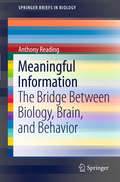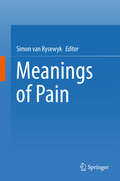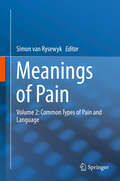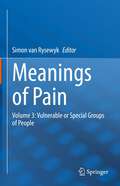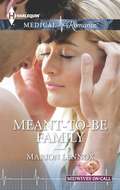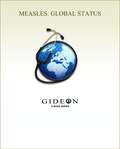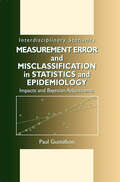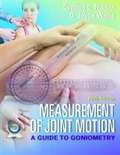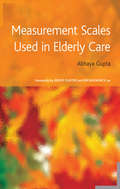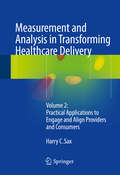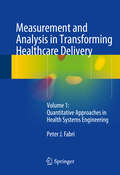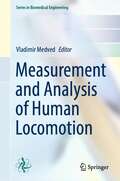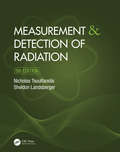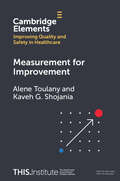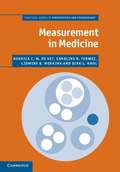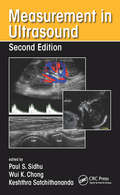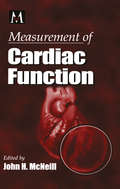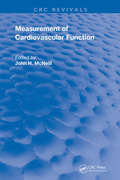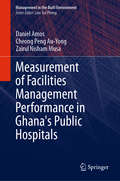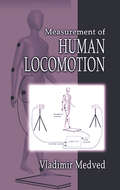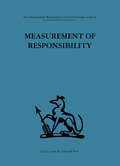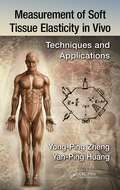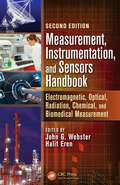- Table View
- List View
Meaningful Information
by Anthony ReadingThe book introduces a radically new way of thinking about information and the important role it plays in living systems. It opens up new avenues for exploring how cells and organisms change and adapt, since the ability to detect and respond to meaningful information is the key that enables them to receive their genetic heritage, regulate their internal milieu, and respond to changes in their environment. It also provides a way of resolving Descartes' dilemma by explaining the workings of the brain in non-mechanical terms that are not tainted by spiritual or metaphysical beliefs. The types of meaningful information that different species and different cell types are able to detect are finely matched to the ecosystem in which they live, for natural selection has shaped what they need to know to function effectively in those circumstances. Biological detection and response systems range from the chemical configurations that govern genes and cell life to the relatively simple tropisms that guide single-cell organisms, the rudimentary nervous systems of invertebrates, and the complex neuronal structures of mammals and primates. The scope of meaningful information that can be detected and responded to reaches its peak in our own species, as exemplified by our special abilities in language, cognition, emotion, and consciousness, all of which are explored within this new framework.
Meanings of Pain
by Simon RysewykAlthough pain is widely recognized by clinicians and researchers as an experience, pain is always felt in a patient-specific way rather than experienced for what it objectively is, making perceived meaning important in the study of pain. The book contributors explain why meaning is important in the way that pain is felt and promote the integration of quantitative and qualitative methods to study meanings of pain. For the first time in a book, the study of the meanings of pain is given the attention it deserves. All pain research and medicine inevitably have to negotiate how pain is perceived, how meanings of pain can be described within the fabric of a person's life and neurophysiology, what factors mediate them, how they interact and change over time, and how the relationship between patient, researcher, and clinician might be understood in terms of meaning. Though meanings of pain are not intensively studied in contemporary pain research or thoroughly described as part of clinical assessment, no pain researcher or clinician can avoid asking questions about how pain is perceived or the types of data and scientific methods relevant in discovering the answers.
Meanings of Pain: Volume 2: Common Types of Pain and Language
by Simon Van RysewykExperiential evidence shows that pain is associated with common meanings. These include a meaning of threat or danger, which is experienced as immediately distressing or unpleasant; cognitive meanings, which are focused on the long-term consequences of having chronic pain; and existential meanings such as hopelessness, which are more about the person with chronic pain than the pain itself. This interdisciplinary book - the second in the three-volume Meanings of Pain series edited by Dr Simon van Rysewyk - aims to better understand pain by describing experiences of pain and the meanings these experiences hold for the people living through them. The lived experiences of pain described here involve various types of chronic pain, including spinal pain, labour pain, rheumatic pain, diabetic peripheral neuropathic pain, fibromyalgia, complex regional pain syndrome, endometriosis-associated pain, and cancer-related pain. Two chapters provide narrative descriptions of pain, recounted and interpreted by people with pain.Language is important to understanding the meaning of pain since it is the primary tool human beings use to manipulate meaning. As discussed in the book, linguistic meaning may hold clues to understanding some pain-related experiences, including the stigmatisation of people with pain, the dynamics of patient-clinician communication, and other issues, such as relationships between pain, public policy and the law, and attempts to develop a taxonomy of pain that is meaningful for patients. Clinical implications are described in each chapter.This book is intended for people with pain, their family members or caregivers, clinicians, researchers, advocates, and policy makers.“It is my opinion that this ... work will stand as the definitive reference work in this field. I believe it will enrich the professional and personal lives of health care providers, researchers and people who have persistent pain and their family members. The combination of framework chapters with chapters devoted to analysing the lived experience of pain conditions gives the requisite breadth and depth to the subject.” - Dr Marc A. Russo, MBBS DA(UK) FANZCA FFPMANZCA, Newcastle, Australia, from the Foreword
Meanings of Pain: Volume 3: Vulnerable or Special Groups of People
by Simon Van RysewykThis book, the third and final volume in the Meaning of Pain series, describes what pain means to people with pain in “vulnerable” groups, and how meaning changes pain – and them – over time.Immediate pain warns of harm or injury to the person with pain. If pain persists over time, more complex meanings can become interwoven with this primitive meaning of threat. These cognitive meanings include thoughts and anxiety about the adverse consequences of pain. Such meanings can nourish existential sufferings, which are more about the person than the pain, such as loss, loneliness, or despair. Although chronic pain can affect anyone, there are some groups of people for whom particular clinical support and understanding is urgently needed. This applies to “vulnerable” or “special” groups of people, and to the question of what pain means to them. These groups include children, women, older adults, veterans, addicts, people with mental health problems, homeless people, or people in rural or indigenous communities. Several chapters in the book focus on the lived experience of pain in vulnerable adults, including black older adults in the US, rural Nigerians, US veterans, and adults with acquired brain injury. The question of what pain experience could mean in the defenceless fetus, neonate, pre-term baby, and child, is examined in depth across three contributions.This book series aspires to create a vocabulary on the “meanings of pain” and a clinical framework with which to use it. It is hoped that the series stimulates self-reflection about the role of meaning in optimal pain management. Meanings of Pain is intended for people with pain, family members or caregivers of people with pain, clinicians, researchers, advocates, and policy makers. Volume I was published in 2016; Volume II in 2019.
Meant-to-Be Family
by Marion LennoxMeant to be a daddy? When obstetrician Oliver Evans walked away from his wife, Emily, he hoped it would allow her the chance to be a mom-something he just couldn't give her. But now Emily has crashed back into his life, and Oliver knows that this time he can never let her go! Midwife Emily has pieced together her own little family, and Oliver's return changes everything. It's clear that what they once had isn't over, but if Oliver wants her back he'll have to believe that being a dad can finally heal his heart...
Measles and Related Morbilliviruses: Methods and Protocols (Methods in Molecular Biology #2808)
by Dzwokai Z. Ma Christian K. PfallerThis volume covers the latest protocols used to study the molecular biology of morbilliviruses, including cell entry, replication, and virus-host interactions. The chapters in this book also cover methods for studying morbillivirus infection through the use of novel tissue culture and in vivo models; analyzing the biological implications of infection by using primary tissues isolated from infected animals; and exploring diagnostic tools to evaluate humoral immunity against human-pathogenic measles virus (MeV). Written in the highly successful Methods in Molecular Biology series format, chapters include introductions to their respective topics, lists of the necessary materials and reagents, step-by-step, readily reproducible laboratory protocols, and tips on troubleshooting and avoiding known pitfalls.Cutting-edge and comprehensive, Measles and Related Morbilliviruses: Methods and Protocols is a valuable resource for researchers studying MeV,and will be useful to researchers studying other members of Paramyxoviridae and Mononegavirales.
Measles: Global Status 2010 edition
by Dr Stephen Berger Gideon InformaticsMeasles: Global Status is one in a series of GIDEON ebooks which summarize the status of individual infectious diseases, in every country of the world. Data are based on the GIDEON database (www.gideononline.com) which relies on standard text books, peer-review journals, Health Ministry reports and ProMED, supplemented by an ongoing search of the medical literature. Chapters are arranged alphabetically, by country name. Each section is divided into five subsections. 1. Descriptive epidemiology 2. Summary of clinical features 3. Global status of the disease 4. Status of the disease in a specific country 5. References
Measurement Error and Misclassification in Statistics and Epidemiology: Impacts and Bayesian Adjustments (Chapman & Hall/CRC Interdisciplinary Statistics)
by Paul GustafsonMismeasurement of explanatory variables is a common hazard when using statistical modeling techniques, and particularly so in fields such as biostatistics and epidemiology where perceived risk factors cannot always be measured accurately. With this perspective and a focus on both continuous and categorical variables, Measurement Error and Misclassification in Statistics and Epidemiology: Impacts and Bayesian Adjustments examines the consequences and Bayesian remedies in those cases where the explanatory variable cannot be measured with precision. The author explores both measurement error in continuous variables and misclassification in discrete variables, and shows how Bayesian methods might be used to allow for mismeasurement. A broad range of topics, from basic research to more complex concepts such as "wrong-model" fitting, make this a useful research work for practitioners, students and researchers in biostatistics and epidemiology."
Measurement Of Joint Motion: A Guide To Goniometry
by Cynthia Norkin D. WhiteFor the physical therapy student. Rely on the 4th Edition of this popular manual to teach you how to perform the skills essential to identifying impairments and assessing rehabilitation status. For each measurable joint in the body, you'll find a consistent, easy-to-follow format and exceptional photographs that depict stabilization during range of motion and alignment, making it easy for you to visualize the examination and technique for each joint motion and muscle length test. Contains: expanded chapter on postural assessment; new content and examples on the use of bubble inclinometers, thorabites, and measuring of the forearm pronation/supination using a pen; range of motion and normative value boxes in each chapter; superb coverage of muscle-length testing; excellent descriptions of normal end-feel patterns; lab exercises and examples throughout.
Measurement Scales Used in Elderly Care
by Almas Rehman Abhaya GuptaThis unique, concise ready reference for daily use collates for the first time the most useful, practical and simple assessment scales used in geriatric settings. It provides tools to identify clinical conditions and health outcomes objectively and reliably. It is essential as a clinical primer and everyday reference guide for all practising and training members of multidisciplinary teams, including consultants and doctors in specialist training, career grade doctors and general practitioners, and medical students; nurses, health visitors, dieticians, and social workers; allied health professionals such as physiotherapists, occupational therapists, speech and language therapists; and managers of elderly care services.'Assessment is central to the practice of Geriatric Medicine. All members of the multidisciplinary team require a sound knowledge of the basic principles of measurement scales. We need to be competent in using and selecting appropriate scales, understanding which scales are valid and fit for purpose. Unfortunately, up to now, this has been a difficult task often requiring reference to original papers. Dr Gupta's scholarship has come to the rescue. He has trawled through the many hundreds of scales available selecting those most useful for the specialty.This book will be valuable to all members of the multidisciplinary team. Dr Gupta has done an excellent job outlining the theory and practice of measurement scales. He has put together an extremely useful compendium of scales. I congratulate him and wish his publication every success. I can foresee this publication becoming an essential text for every unit library and valuable book for individual clinicians.' - Dr Jeremy Playfer in his Foreword. 'This book summarises the most commonly used validated assessment scales which can be used by medical students, postgraduate trainees, consultants and the multi-disciplinary team members. I hope a copy of this book will be kept on every ward, outpatient department and GP practice for daily use and reference' - Professor Bim Bhowmick OBE in his Foreword.
Measurement and Analysis in Transforming Healthcare Delivery
by Harry C. SaxThis volume is complementary to Volume 1: Quantitative Approaches in Health Systems Engineering which provides in-depth analysis of the statistical and quantitative aspects of Health Systems Engineering. Volume 2: Practical Applications to Engage and Align Providers and Consumers builds upon these concepts with the integration of additional economic, performance and quality measures. Stressing the importance of changes in the economics of health care financing, it will serve as a resource for not only leaders of organizations, but also providers who will be practicing a different type of medicine from that of which they were trained. After defining the challenges, the authors will quantify and define funds flows and various margins necessary for viability, how providers will be measured and rewarded for quality, and the importance of accurate dashboard of physician performance. Types of payment systems, including capitation, ACOs, risk contracts, and hybrid forms of fee for service will be defined and their relative advantages discussed. Lessons from other countries that provide high quality care at a lower cost will be examined for applicability to our challenges. Finally, experts in leadership will focus on influencing behavior to achieve results while remembering that healthcare is about the patient. This textbook will serve as a useful resource for clinicians, healthcare executives, governmental agencies, and emerging leaders in organizations.
Measurement and Analysis in Transforming Healthcare Delivery
by Peter J. FabriThis volume provides the important concepts necessary for a physician to participate in a reengineering process, develop decision-making skills based on probability and logic rather than "rules," and to measure and analyze meaningful outcomes of care delivery. This approach has been developed over ten years in a medical student-based program and has been enthusiastically embraced by medical students without backgrounds in engineering or statistics. More specifically, this text will introduce physicians to relevant and available computer software, combined with an in depth knowledge of measurement, variation, and uncertainty. It provides a basis for the transformation of data into information, information into knowledge, and knowledge into wisdom. The first quarter of the book will address understanding and visualizing data, using statistical and graphic analysis. The next quarter addresses the fundamentals of applied statistics, and the application of conditional probability to clinical decision making. The next quarter addresses the four "cornerstones" of modern analytics: regression, classification, association analysis, and clustering. The final section addresses the identification of outliers and their importance in understanding, the assessment of cause and effect and the limitations associated with retrospective data analysis. This toolbox will prepare the interested physician to actively engage in the identification of problem areas, the design of process-based solutions, and the continuous assessment of outcomes of clinical practice. Armed with this toolbox, the reader will be "prepared to make a difference" in the rapidly changing world of healthcare delivery. Measurement and Analysis in Transforming Healthcare Delivery is an excellent resource for general practitioners, health administrators, and all medical professionals interacting with healthcare delivery.
Measurement and Analysis of Human Locomotion (Series in Biomedical Engineering)
by Vladimir MedvedThis book addresses instruments, methodologies and diagnostic methods used to evaluate and diagnose human movement, locomotion and physical status in general. Starting from historical perspective, the idea of understanding human locomotion by applying technical measurement devices and incorporating measurement data into physical representation of gross body movement is presented and explained, an approach known as inverse dynamics. With this approach as a kind of umbrella concept, components of measurement systems including relevant signal and data processing methods are described. Modern instruments to capture body movement by measuring its kinematics, kinetics and surface electromyography (sEMG) are thus described; all systems being used dominantly—if not exclusively—in a movement analysis laboratory setting. Focusing mainly on human posture and gait, but including also examples of movement patterns from selected kinesiological and sports activities, the book attempts to present essentials of biomechanics and biomedical engineering approach to this subject matter. It illustrates how data collected and elaborated by modern engineering technology can complement traditional expert knowledge of a kinesiologist or a medical doctor. The book is applicable in the fields of sports, physical activities, as well as in medical diagnostics and rehabilitation. The examples of this book’s practical application might be in evaluation of efficiency of human gait, in evaluation of skeletal muscle fatigue in physical exercise, in biomechanical diagnostics of traumatological conditions requiring orthopaedic treatment and the like. This book can also be used in planning and executing research endeavours, particularly in a clinical context as a reference for various diagnostics procedures. It presents the lecture notes of a course carrying the same name within Medical Studies in English at the University of Zagreb for more than a decade.
Measurement and Detection of Radiation
by Nicholas Tsoulfanidis Sheldon LandsbergerAs useful to students and nuclear professionals as its popular predecessors, this fifth edition provides the most up-to-date and accessible introduction to radiation detector materials, systems, and applications. There have been many advances in the field of radiation detection, most notably in practical applications. Incorporating these important developments, Measurement and Detection of Radiation, Fifth Edition provides the most up-to-date and accessible introduction to radiation detector materials, systems, and applications. It also includes more problems and updated references and bibliographies, and step-by-step derivations and numerous examples illustrate key concepts. New to the Fifth Edition:• Expanded chapters on semiconductor detectors, data analysis methods, health physics fundamentals, and nuclear forensics.• Updated references and bibliographies.• New and expanded problems.
Measurement for Improvement (Elements of Improving Quality and Safety in Healthcare)
by Alene Toulany Kaveh G. ShojaniaThe main principles underpinning measurement for healthcare improvement are outlined in this Element. Although there is no single formula for achieving optimal measurement to support improvement, a fundamental principle is the importance of using multiple measures and approaches to gathering data. Using a single measure falls short in capturing the multifaceted aspects of care across diverse patient populations, as well as all the intended and unintended consequences of improvement interventions within various quality domains. Even within a single domain, improvement efforts can succeed in several ways and go wrong in others. Therefore, a family of measures is usually necessary. Clearly communicating a plausible theory outlining how an intervention will lead to desired outcomes informs decisions about the scope and types of measurement used. Improvement teams must tread carefully to avoid imposing undue burdens on patients, clinicians, or organisations. This title is also available as Open Access on Cambridge Core.
Measurement in Medicine
by Dirk L. Knol Henrica C. de Vet Caroline B. Terwee Lidwine B. MokkinkThe success of the Apgar score demonstrates the astounding power of an appropriate clinical instrument. This down-to-earth book provides practical advice, underpinned by theoretical principles, on developing and evaluating measurement instruments in all fields of medicine. It equips you to choose the most appropriate instrument for specific purposes. The book covers measurement theories, methods and criteria for evaluating and selecting instruments. It provides methods to assess measurement properties, such as reliability, validity and responsiveness, and interpret the results. Worked examples and end-of-chapter assignments use real data and well-known instruments to build your skills at implementation and interpretation through hands-on analysis of real-life cases. All data and solutions are available online. This is a perfect course book for students and a perfect companion for professionals/researchers in the medical and health sciences who care about the quality and meaning of the measurements they perform.
Measurement in Medicine
by Dirk L. Knol Caroline B. Terwee Lidwine B. Mokkink Henrica C. W. de VetThe success of the Apgar score demonstrates the astounding power of an appropriate clinical instrument. This down-to-earth book provides practical advice, underpinned by theoretical principles, on developing and evaluating measurement instruments in all fields of medicine. It equips you to choose the most appropriate instrument for specific purposes. The book covers measurement theories, methods and criteria for evaluating and selecting instruments. It provides methods to assess measurement properties, such as reliability, validity and responsiveness, and interpret the results. Worked examples and end-of-chapter assignments use real data and well-known instruments to build your skills at implementation and interpretation through hands-on analysis of real-life cases. All data and solutions are available online. This is a perfect course book for students and a perfect companion for professionals/researchers in the medical and health sciences who care about the quality and meaning of the measurements they perform.
Measurement in Ultrasound: A Practical Handbook
by Paul S. Sidhu Wui K. Chong Keshthra SatchithanandaMeasurement and interpretation of key ultrasound parameters are essential to differentiate normal anatomy from pathology. By using Measurement in Ultrasound, trainee radiologists and ultrasonographers can gain an appreciation of such measurements, while practitioners can use it as a valuable reference in the clinical setting. <P><P>The book follows a consistent format throughout for ease of reference and features useful information on preparation and positioning of the patient for ultrasound, the type of transducer and method to be used, the appearance of the resulting ultrasound images and the measurements to be derived from them. <P><P>Designed for frequent use in everyday practice, the book includes more than 150 high-quality ultrasound images annotated with key measurements and accompanied by concise explanatory text. Normal variants are provided, along with ranges for features that can change during development and in disease. <P><P>This new edition covers relevant developments in ultrasound. Where appropriate, updated ultrasound measurements that have arisen are also included and key references are provided as an aid to further study.
Measurement of Cardiac Function: Approaches, Techniques, and Troubleshooting
by John H. McNeillThis book presents detailed descriptions of how to set up and use several classical cardiac preparations from scratch, including whole heart, atrial, ventricular, and papillary muscles and in vivo small animal preparations. It describes methods for monitoring contraction and contractility.
Measurement of Cardiovascular Function (Routledge Revivals)
by John H. McNeillFirst Published in 1997, Measurement of Cardiovascular Function answers the crucial need for a straightforward guide for cardiac researchers to develop techniques from scratch in the laboratory. The techniques detailed represent major models and methods used in assessing cardiac function in physiological and pathological conditions. The book presents in-depth descriptions of several sophisticated cardiac preparations and includes chapters on the lipid-perfused heart, metabolic measurements, models of arrhythmia, blood pressure monitoring, and models of hypertension.This book examines the most widely used tools in experimental cardiology and provides you with the recipe-setting up the technique, procurement of equipment, sample data and calculations, problems and trouble shooting, adapting to other species, modifications, and applicability. Undoubtedly, this text will be a great asset to cardiovascular physiologists, pharmacologists, experimental cardiologists, and students of physiology and pharmacology.
Measurement of Facilities Management Performance in Ghana's Public Hospitals (Management in the Built Environment)
by Daniel Amos Cheong Peng Au-Yong Zairul Nisham MusaThis book presents the concept of healthcare facilities management performance measurement (HCFMPM) using Ghana as a case study. It set forth in-depth theoretical and empirical underpinnings of performance measurement concepts for hospital facilities services, with the view to demonstrate critical performance dimensions to improve FM contributions and added value to healthcare delivery. The research approach adopted is mixed method encompassing qualitative interviews in case study setting and a questionnaire survey of sampled hospitals in Ghana. The book presents a number of useful tables, graphs as well as a pedagogic illustration of statistical analysis which are useful in understanding the concepts under reference. It develops a structural equation model for performance measurement of FM services. The book is of relevance to healthcare managers, facilities management practitioners and academics towards measuring and improving FM performance in hospitals. Although the data used in the analysis is based on the case study country Ghana, the result is by extension useful to several developing countries faced with the challenge to improve FM services delivery in public hospitals as well as other facilities management sectors.
Measurement of Human Locomotion
by Vladimir MedvedThe importance of measurements for the proper assessment of human locomotion is increasingly being recognized. The fields of application encompass both healthy and pathological locomotion as encountered in rehabilitation medicine, orthopedics, kinesiology, sports medicine, and the like. Measurement of Human Locomotion provides an up-to-date des
Measurement of Responsibility: A study of work, payment, and individual capacity (International Behavioural And Social Sciences Ser. #Vol. 51)
by Elliott JaquesTavistock Press was established as a co-operative venture between the Tavistock Institute and Routledge & Kegan Paul (RKP) in the 1950s to produce a series of major contributions across the social sciences. This volume is part of a 2001 reissue of a selection of those important works which have since gone out of print, or are difficult to locate. Published by Routledge, 112 volumes in total are being brought together under the name The International Behavioural and Social Sciences Library: Classics from the Tavistock Press. Reproduced here in facsimile, this volume was originally published in 1956 and is available individually. The collection is also available in a number of themed mini-sets of between 5 and 13 volumes, or as a complete collection.
Measurement of Soft Tissue Elasticity in Vivo: Techniques and Applications
by Yan-Ping Huang Yong-Ping ZhengThe product of 20 years of research, this book covers topics in soft tissue elasticity in vivo, from measurement techniques to clinical applications. It provides, for the first time, a single source that systematically introduces the various techniques for in vivo measurement of soft tissue elasticity in an effort to ease the difficulty between lea
Measurement, Instrumentation, and Sensors Handbook: Electromagnetic, Optical, Radiation, Chemical, and Biomedical Measurement (Electrical Engineering Handbook Ser.)
by John G. Webster Halit ErenThe Second Edition of the bestselling Measurement, Instrumentation, and Sensors Handbook brings together all aspects of the design and implementation of measurement, instrumentation, and sensors. Reflecting the current state of the art, it describes the use of instruments and techniques for performing practical measurements in engineering, physics, chemistry, and the life sciences and discusses processing systems, automatic data acquisition, reduction and analysis, operation characteristics, accuracy, errors, calibrations, and the incorporation of standards for control purposes. Organized according to measurement problem, the Electromagnetic, Optical, Radiation, Chemical, and Biomedical Measurement volume of the Second Edition: Contains contributions from field experts, new chapters, and updates to all 98 existing chapters Covers sensors and sensor technology, time and frequency, signal processing, displays and recorders, and optical, medical, biomedical, health, environmental, electrical, electromagnetic, and chemical variables A concise and useful reference for engineers, scientists, academic faculty, students, designers, managers, and industry professionals involved in instrumentation and measurement research and development, Measurement, Instrumentation, and Sensors Handbook, Second Edition: Electromagnetic, Optical, Radiation, Chemical, and Biomedical Measurement provides readers with a greater understanding of advanced applications.
